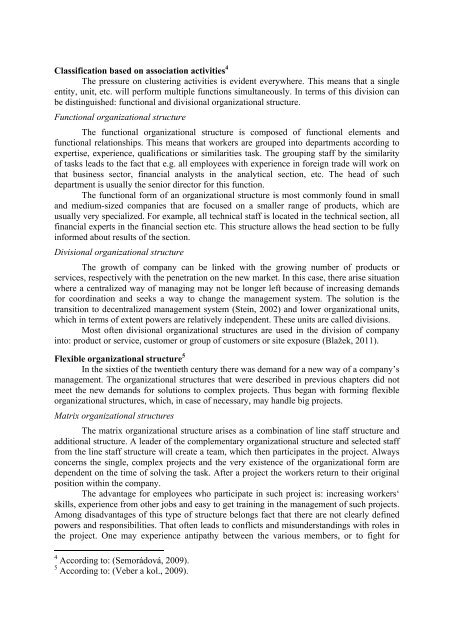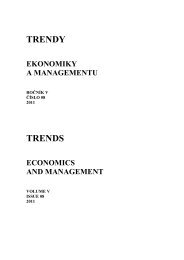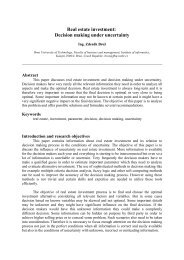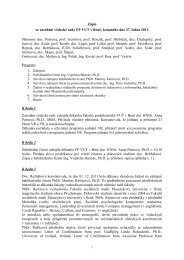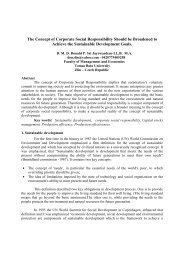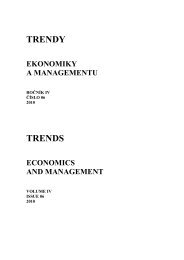Research into the usage of organizational structures in the Czech ...
Research into the usage of organizational structures in the Czech ...
Research into the usage of organizational structures in the Czech ...
You also want an ePaper? Increase the reach of your titles
YUMPU automatically turns print PDFs into web optimized ePapers that Google loves.
Classification based on association activities 4<br />
The pressure on cluster<strong>in</strong>g activities is evident everywhere. This means that a s<strong>in</strong>gle<br />
entity, unit, etc. will perform multiple functions simultaneously. In terms <strong>of</strong> this division can<br />
be dist<strong>in</strong>guished: functional and divisional <strong>organizational</strong> structure.<br />
Functional <strong>organizational</strong> structure<br />
The functional <strong>organizational</strong> structure is composed <strong>of</strong> functional elements and<br />
functional relationships. This means that workers are grouped <strong><strong>in</strong>to</strong> departments accord<strong>in</strong>g to<br />
expertise, experience, qualifications or similarities task. The group<strong>in</strong>g staff by <strong>the</strong> similarity<br />
<strong>of</strong> tasks leads to <strong>the</strong> fact that e.g. all employees with experience <strong>in</strong> foreign trade will work on<br />
that bus<strong>in</strong>ess sector, f<strong>in</strong>ancial analysts <strong>in</strong> <strong>the</strong> analytical section, etc. The head <strong>of</strong> such<br />
department is usually <strong>the</strong> senior director for this function.<br />
The functional form <strong>of</strong> an <strong>organizational</strong> structure is most commonly found <strong>in</strong> small<br />
and medium-sized companies that are focused on a smaller range <strong>of</strong> products, which are<br />
usually very specialized. For example, all technical staff is located <strong>in</strong> <strong>the</strong> technical section, all<br />
f<strong>in</strong>ancial experts <strong>in</strong> <strong>the</strong> f<strong>in</strong>ancial section etc. This structure allows <strong>the</strong> head section to be fully<br />
<strong>in</strong>formed about results <strong>of</strong> <strong>the</strong> section.<br />
Divisional <strong>organizational</strong> structure<br />
The growth <strong>of</strong> company can be l<strong>in</strong>ked with <strong>the</strong> grow<strong>in</strong>g number <strong>of</strong> products or<br />
services, respectively with <strong>the</strong> penetration on <strong>the</strong> new market. In this case, <strong>the</strong>re arise situation<br />
where a centralized way <strong>of</strong> manag<strong>in</strong>g may not be longer left because <strong>of</strong> <strong>in</strong>creas<strong>in</strong>g demands<br />
for coord<strong>in</strong>ation and seeks a way to change <strong>the</strong> management system. The solution is <strong>the</strong><br />
transition to decentralized management system (Ste<strong>in</strong>, 2002) and lower <strong>organizational</strong> units,<br />
which <strong>in</strong> terms <strong>of</strong> extent powers are relatively <strong>in</strong>dependent. These units are called divisions.<br />
Most <strong>of</strong>ten divisional <strong>organizational</strong> <strong>structures</strong> are used <strong>in</strong> <strong>the</strong> division <strong>of</strong> company<br />
<strong><strong>in</strong>to</strong>: product or service, customer or group <strong>of</strong> customers or site exposure (Blažek, 2011).<br />
Flexible <strong>organizational</strong> structure 5<br />
In <strong>the</strong> sixties <strong>of</strong> <strong>the</strong> twentieth century <strong>the</strong>re was demand for a new way <strong>of</strong> a company’s<br />
management. The <strong>organizational</strong> <strong>structures</strong> that were described <strong>in</strong> previous chapters did not<br />
meet <strong>the</strong> new demands for solutions to complex projects. Thus began with form<strong>in</strong>g flexible<br />
<strong>organizational</strong> <strong>structures</strong>, which, <strong>in</strong> case <strong>of</strong> necessary, may handle big projects.<br />
Matrix <strong>organizational</strong> <strong>structures</strong><br />
The matrix <strong>organizational</strong> structure arises as a comb<strong>in</strong>ation <strong>of</strong> l<strong>in</strong>e staff structure and<br />
additional structure. A leader <strong>of</strong> <strong>the</strong> complementary <strong>organizational</strong> structure and selected staff<br />
from <strong>the</strong> l<strong>in</strong>e staff structure will create a team, which <strong>the</strong>n participates <strong>in</strong> <strong>the</strong> project. Always<br />
concerns <strong>the</strong> s<strong>in</strong>gle, complex projects and <strong>the</strong> very existence <strong>of</strong> <strong>the</strong> <strong>organizational</strong> form are<br />
dependent on <strong>the</strong> time <strong>of</strong> solv<strong>in</strong>g <strong>the</strong> task. After a project <strong>the</strong> workers return to <strong>the</strong>ir orig<strong>in</strong>al<br />
position with<strong>in</strong> <strong>the</strong> company.<br />
The advantage for employees who participate <strong>in</strong> such project is: <strong>in</strong>creas<strong>in</strong>g workers‘<br />
skills, experience from o<strong>the</strong>r jobs and easy to get tra<strong>in</strong><strong>in</strong>g <strong>in</strong> <strong>the</strong> management <strong>of</strong> such projects.<br />
Among disadvantages <strong>of</strong> this type <strong>of</strong> structure belongs fact that <strong>the</strong>re are not clearly def<strong>in</strong>ed<br />
powers and responsibilities. That <strong>of</strong>ten leads to conflicts and misunderstand<strong>in</strong>gs with roles <strong>in</strong><br />
<strong>the</strong> project. One may experience antipathy between <strong>the</strong> various members, or to fight for<br />
4 Accord<strong>in</strong>g to: (Semorádová, 2009).<br />
5 Accord<strong>in</strong>g to: (Veber a kol., 2009).


